Related Research Articles

The SD80MAC was a 5,000 horsepower (3.7 MW) C-C diesel-electric locomotive. It was powered by a 20-cylinder version of EMD's 710G prime mover, and was the second diesel locomotive by GM-EMD to use a V20 engine, since EMD's SD45 series. It introduced a wide radiator housing similar to GE Transportation locomotives and the placement of dynamic brakes at the rear of the locomotive, which is a quieter location, features that were incorporated into the SD90MAC and SD70ACe models. Key spotting differences between the SD80MAC and SD90MAC include no external rear sandbox on the SD90MAC, no rear lighted number boards on the SD90MAC, and the placement of the front numberboards. The SD80MAC also had recessed red marker lights in the nose, an identifying feature unique to Conrail (CR) locomotives, although Norfolk Southern (NS) had removed the lights on most of their former Conrail engines.

General Motors Diesel was a railway diesel locomotive manufacturer located in London, Ontario, Canada. It was established in 1949 as the Canadian subsidiary of the Electro-Motive Diesel division of General Motors (EMD). In 1969 it was re-organized as the "Diesel Division of General Motors of Canada, Ltd." The plant was re-purposed to include manufacture of other diesel-powered General Motors vehicles such as buses. Following the Canada-United States Free Trade Agreement in 1989, all of EMD's locomotives were built at the London facility. In 2005 new owners of EMD renamed the Canadian subsidiary "Electro-Motive Canada". The plant was closed by EMD's new owner Progress Rail in 2012, with EMD's production remaining in LaGrange, Illinois and Muncie, Indiana.
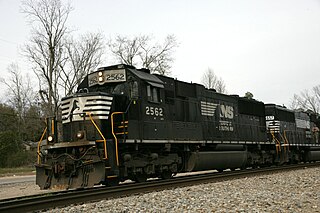
The EMD SD70 is a series of diesel-electric locomotives produced by the US company Electro-Motive Diesel in response to the GE Dash 9-44CW. This locomotive family is an extension and improvisation to the EMD SD60 series. Production commenced in late 1992 and since then over 5,700 units have been produced; most of these are the SD70M, SD70MAC, and SD70ACe models. While the majority of the production was ordered for use in North America, various models of the series have been used worldwide. All locomotives of this series are hood units with C-C trucks, except the SD70ACe-P4 and SD70MACH which have a B1-1B wheel configuration, and the SD70ACe-BB, which has a B-B-B-B wheel arrangement.

The EMD SD90MAC is a model of 6,000 hp (4,470 kW) C-C diesel-electric locomotive produced by General Motors Electro-Motive Division (EMD). It is, with the SD80MAC, one of the largest single-engined locomotives produced by EMD, surpassed only by the dual-engined DDA40X.
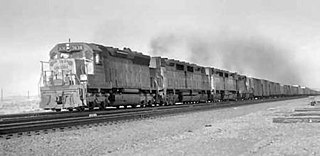
The EMD DD35 was a 5,000 horsepower (3,700 kW) diesel-electric locomotive of D-D wheel arrangement built by General Motors Electro-Motive Division for the Union Pacific Railroad and Southern Pacific Railroad.

Electro-Motive Diesel is a brand of diesel-electric locomotives, locomotive products and diesel engines for the rail industry. Formerly a division of General Motors, EMD is now owned by Progress Rail, a subsidiary of Caterpillar Inc. Electro-Motive Diesel traces its roots to the Electro-Motive Engineering Corporation, founded in 1922 and purchased by General Motors in 1930. After purchase by GM, the company was known as GM's Electro-Motive Division. In 2005, GM sold EMD to Greenbriar Equity Group and Berkshire Partners, and in 2010, EMD was sold to Progress Rail. Upon the 2005 sale, the company was renamed to Electro-Motive Diesel.
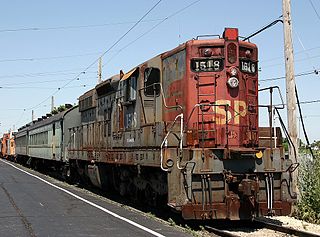
The SD7 is a model of 6-axle diesel locomotive built by General Motors Electro-Motive Division between May 1951 and November 1953. It had an EMD 567B 16-cylinder engine producing 1,500 horsepower (1.12 MW) for its six traction motors. United States railroads bought 188 units.

An SDP40 is a 6-axle passenger diesel-electric locomotive built by General Motors Electro-Motive Division (EMD) between June 1966 and May 1970.

The EMD Model 40 was a two-axle diesel-electric switcher locomotive built by Electro-Motive Corporation (EMC), and its corporate successor, General Motors' Electro-Motive Division (EMD) between August 1940 and April 1943. Nicknamed "critters", eleven examples of this locomotive were built. Powered by twin General Motors Detroit Diesel 6-71 diesel engines, which produce a combined 300 horsepower (224 kW), its drivetrain is unusual because the two diesel engines are used to drive the electric DC generator from both sides, one with clockwise rotation and the other with counter-clockwise rotation.
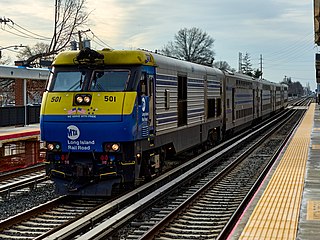
The EMD DE30AC and DM30AC are a class of 46 locomotives built between 1997–1999 by Electro-Motive Division in the Super Steel Plant in Schenectady, New York, for the Long Island Rail Road of the Metropolitan Transportation Authority (MTA) in New York. Originally divided equally between the two types, the fleet currently consists of 24 DE30AC locomotives and 20 DM30AC locomotives.

The Stadler Euro is a class of diesel-electric locomotives built by Stadler Rail for the European market. It is available in two basic variants, the four-axle Euro 3000, and the six-axle Euro 4000. These locomotives are powered by EMD 710 prime movers. A six-axle electric-only variant is marketed as Euro 6000; it is also built for the Iberian gauge.
Progress Rail Services Corporation, a fully owned subsidiary of Caterpillar since 2006, is a supplier of railroad and transit system products and services headquartered in Albertville, Alabama. Founded as a recycling company in 1982, Progress Rail has increased the number of its product and service offerings over time to become one of the largest integrated and diversified suppliers of railroad and transit system products and services in North America. Progress Rail markets products and services worldwide and maintains 110 facilities in the United States, 34 in Mexico, 4 in Canada, 2 in Brazil, 5 in the UK, 1 in Italy, and 1 in Germany. Progress Rail is organized into two divisions: Infrastructure and Rolling Stock.
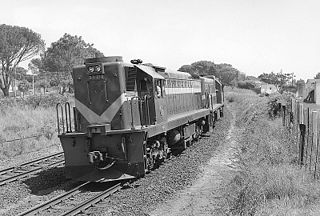
The South African Railways Class 33-200 of 1966 was a diesel-electric locomotive.

The South African Railways Class 34-200 of 1971 is a diesel-electric locomotive.

The South African Railways Class 34-600 of 1974 is a diesel-electric locomotive.

The South African Railways Class 35-200 of 1974 is a diesel-electric locomotive.

The South African Railways Class 35-600 of 1976 is a branch line diesel-electric locomotive.

The South African Railways Class 61-000 of 1959 was a diesel-hydraulic locomotive.

The South African Railways Class 37-000 of 1981 is a mainline diesel-electric locomotive.

The Spoornet Class 39-000 of 2006 is a South African diesel-electric locomotive from the Spoornet era.
References
- 1 2 "EMD GM6W". railfan.net. Retrieved 4 May 2009.
- 1 2 "CFS Motive Power" . Retrieved 4 May 2009.
- 1 2 South African Industrials (Buffelsfontein Gold Mines)